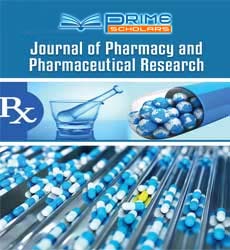Short Communication - (2022) Volume 6, Issue 5
Principles of Drug Design
Swetha Pandit*
Department of Pharmacy Practice, University of Calcutta, Kolkata, India
*Correspondence:
Swetha Pandit,
Department of Pharmacy Practice, University of Calcutta, Kolkata,
India,
Email:
Received: 03-Oct-2022, Manuscript No. IPIPR-22-14541;
Editor assigned: 05-Oct-2022, Pre QC No. IPIPR-22-14541 (PQ);
Reviewed: 19-Oct-2022, QC No. IPIPR-22-14541 ;
Revised: 24-Oct-2022, Manuscript No. IPIPR-22-14541 (R);
Published:
31-Oct-2022, DOI: 10.21767/IPIPR.22.6.24
INTRODUCTION
Drug design is an integrated development field heralding the era
of “tailored drugs”. It involves studying the effects of bioactive
compounds based on molecular interactions related to molecular
structure or its associated physicochemical properties. Study the
process by which drugs exert their effects, how they react with the
cytoplasm to produce specific pharmacological effects or responses,
how they are modified or detoxified, metabolized or eliminated
from the body. Drugs are most commonly small organic molecules
that activate or inhibit the function of biomolecules, such
as proteins, to provide a therapeutic benefit to patients [1]. At its
simplest, drug design involves designing small molecules that are
complementary in shape and charge to the bio-molecular targets
with which they interact and bind. Pharmaceutical design often,
but not always, relies on computer modeling techniques [2]. This
type of modeling is often referred to as computational drug design.
Finally, drug discovery based on knowledge of the three-dimensional
structure of bio-molecular targets is known as structure-
based drug discovery.
Description
Lipinski’s rule of 5 additionally called the Pfizer’s rule of 5 or sincerely
the Rule of 5 (RO5) is a rule of thumb to assess drug likeness
or decide if a chemical compound with a sure pharmacological or
organic pastime has homes that might make it a probable orally
lively drug in humans. The rule turned into formulated with the
aid of using Christopher A. Lipinski in 1997, primarily based totally
at the remark that maximum remedy tablets are distinctly small
and lipophilic molecules [3]. The rule describes molecular homes
crucial for a drug’s pharmacokinetics with inside the human body,
inclusive of their absorption, distribution, metabolism, and excretion
(“ADME”). However, the guideline of thumb does now no longer
are expecting if a compound is pharmacologically lively. The
modern fashion within side the drug layout is to expand new clinically
powerful sellers thru the structural change of lead nucleus.
The lead is a prototype compound that has the favored organic or
pharmacological pastime however may also have many unwanted
characteristics, like excessive toxicity, different organic pastime, insolubility
or metabolism problems [4]. Such natural leads as soon
as identified, are clean to exploit. This technique is alternatively
straightforward. The actual take a look at is living with the identity
of such lead actual take a look at is living with the identity of such
lead bioactive positions at the fundamental skeleton of such leads
[5]. Drug layout is the innovative procedure of locating new treatments
primarily based totally at the understanding of an organic
target.
Conclusion
Sometimes a drug candidate in the course of medical trials will
show off a couple of pharmacological interest; that is, it is able
to produce a facet effect. This compound, then, may be used as
a lead (or, with luck, as a drug) for the secondary interest. This
assessment discusses precept of drug layout, numerous methods
of drug layout, lead discovery, lead change and numerous styles
of drug discovery. Bioisosterism is a vital lead change method that
has been proven to be beneficial to minimize toxicity or to regulate
the interest of a lead, and might have a sizeable position within
side the alteration of pharmacokinetics of a lead.
Acknowledgement
The author is grateful to the journal editor and the anonymous
reviewers for their helpful comments and suggestions.
Conflict Of Interest
The author declared no potential conflicts of interest for the research,
authorship, and/or publication of this article.
References
- Tashima T (2015) Intriguing possibilities and beneficial aspects of transporter-conscious drug design. Bioorg Med Chem 23(15):4119-4131.
[Crossref] [Google Scholar] [Pubmed]
- Kuwata K (2020) The Principles of protein surgery and its application to the logical drug design for the treatment of neurodegenerative diseases. Prog Mol Biol Transl Sci 175:359-374.
[Crossref] [Google Scholar] [Pubmed]
- Cheirdaris DG (2020) Artificial neural networks in computer-aided drug design: An overview of recent advances.Adv Exp Med Biol 1194:115-125.
[Crossref] [Google Scholar] [Pubmed]
- Zhang J (2021) Current advances in drug design and cancer research. Curr Top Med Chem 21(15):1307-1309.
[Crossref] [Google Scholar] [Pubmed]
- Okamoto Y (2011) Drug design by generalized-ensemble simulations. Curr Pharm Des 17(17):1758-72.
[Crossref] [Google Scholar] [Pubmed]
Citation: Pandit S (2022) Principles of Drug Design. J Pharm Pharm Res.6:24.
Copyright: © 2022 Salvator C. This is an open-access article distributed under the terms of the Creative Commons Attribution
License, which permits unrestricted use, distribution, and reproduction in any medium, provided the original author and source
are credited.

